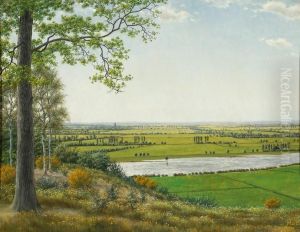Hendrik Johannes De Boer Paintings
Hendrik Johannes De Boer was a Dutch artist, born in the late 19th century in the Netherlands. His artistic journey began in an era when European art was undergoing significant transformations, with movements such as Impressionism, Post-Impressionism, and Expressionism influencing artists around the continent. Although not as widely recognized as the leading figures of these movements, De Boer contributed to the rich tapestry of Dutch art through his dedication to painting and education.
De Boer's work was characterized by its adherence to realism and naturalism, which were prominent styles in the Netherlands during his early career. He was deeply influenced by the Dutch landscape and often depicted rural scenes, everyday life, and the serene countryside. His paintings often captured the subtle interplay of light and shadow, a testament to his observation skills and his ability to render scenes with a quiet, contemplative mood.
Throughout his career, De Boer also engaged in the field of education, believing in the importance of passing on traditional techniques and skills to younger generations of artists. His role as an educator allowed him to influence and mentor numerous students, many of whom would carry on the legacy of the realistic and naturalistic approach to art.
De Boer lived through two World Wars and the significant cultural changes they brought about. These events inevitably shaped his perspective as an artist and an individual. Despite the changing art world around him, with the advent of abstract and conceptual art, De Boer remained dedicated to his style, which emphasized the beauty of the observed world.
Hendrik Johannes De Boer's contributions to Dutch art may not have garnered international fame, but within his own context, he was respected for his steadfast approach to painting and his dedication to art education. He continued to work and teach until his later years, leaving behind a body of work that celebrated the Dutch landscape and way of life. De Boer passed away in 1980, leaving a legacy as an artist committed to the representation of his immediate world and the education of aspiring painters.
